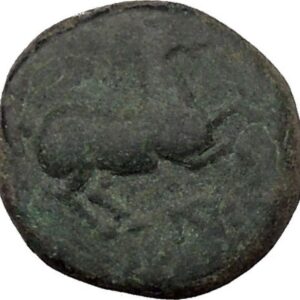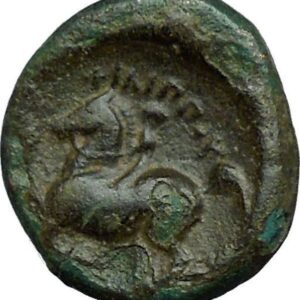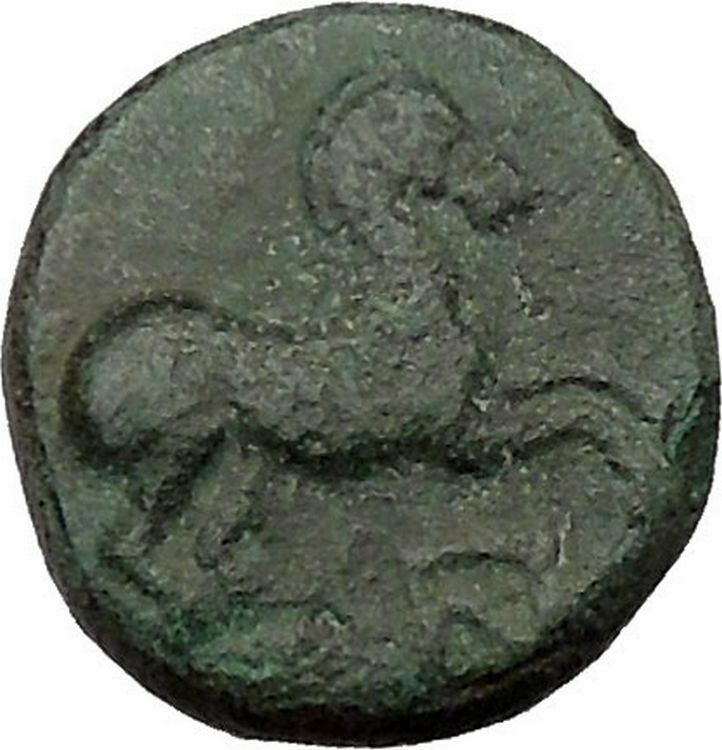|
Greek city of
Elaiussa in
Cilicia
Bronze 19mm (4.97 grams) Struck 1st Century B.C.
Reference: Sear 5680 var.; SNG Levante 826 var.
Head of Zeus right, bound with tainia.
Nike advancing left, holding wreath; EΛΑΙΟVΣΙΩΝ
before.
You are bidding on the exact item pictured,
provided with a Certificate of Authenticity and Lifetime Guarantee of
Authenticity.
In the
ancient Greek
religion, Zeus was the
“Father of Gods and men” (πατὴρ ἀνδρῶν τε θεῶν
τε)
who ruled the Olympians of
Mount Olympus
as a father ruled the family. He was the
god of sky
and
thunder
in
Greek mythology
.
His
Roman
counterpart is
Jupiter
and
Etruscan
counterpart is Tinia
.![The Jupiter de Smyrne, discovered in Smyrna in 1680[1]](https://upload.wikimedia.org/wikipedia/commons/thumb/c/c8/Jupiter_Smyrna_Louvre_Ma13.jpg/200px-Jupiter_Smyrna_Louvre_Ma13.jpg)
Zeus was the child of
Cronus
and
Rhea
,
and the youngest of his siblings. In most traditions he was married to
Hera, although, at the
oracle of Dodona
,
his consort was
Dione
:
according to the Iliad
,
he is the father of
Aphrodite
by Dione. He is known for his erotic escapades. These resulted in many godly and
heroic offspring, including
Athena
,
Apollo
and Artemis
,
Hermes
,
Persephone
(by Demeter
),
Dionysus
,
Perseus
,
Heracles
,
Helen of Troy
,
Minos
,
and the Muses
(by Mnemosyne
);
by Hera, he is usually said to have fathered
Ares,
Hebe
and Hephaestus
.
As
Walter Burkert
points out in his book, Greek Religion, “Even the gods who are not his
natural children address him as Father, and all the gods rise in his presence.”
For the Greeks, he was the
King of the Gods
,
who oversaw the universe. As
Pausanias
observed, “That Zeus is king in heaven is a saying common to all men”. In
Hesiod’s Theogony
Zeus assigns the various gods their roles. In the Homeric Hymns he is
referred to as the chieftain of the gods.
His symbols are the
thunderbolt
,
eagle
,
bull
,
and oak
.
In addition to his Indo-European inheritance, the classical “cloud-gatherer”
also derives certain iconographic traits from the cultures of the
Ancient Near East
,
such as the
scepter

In
Greek mythology
,
Nike
was a
goddess
who personified
victory
, also known as the Winged Goddess of
Victory. The Roman equivalent was
Victoria
. Depending upon the time of various
myths, she was described as the daughter of
Pallas
(Titan) and
Styx (Water) and the sister of
Kratos
(Strength),
Bia
(Force), and
Zelus
(Zeal). Nike and her siblings were close
companions of Zeus
, the dominant deity of the
Greek pantheon
. According to classical (later)
myth, Styx brought them to Zeus when
the
god was assembling allies for the
Titan War
against the older deities. Nike
assumed the role of the divine
charioteer
, a role in which she often is
portrayed in Classical Greek art. Nike flew around battlefields rewarding the
victors with glory and fame.
Nike is seen with wings in most statues and paintings. Most other winged
deities in the Greek pantheon had shed their wings by Classical times. Nike is
the goddess of strength, speed, and victory. Nike was a very close acquaintance
of Athena
, and is thought to have stood in
Athena’s outstretched hand in the statue of Athena located in the Parthenon.
Nike is one of the most commonly portrayed figures on Greek coins.
Names stemming from Nike include amongst others:
Nicholas
, Nicola, Nick, Nikolai, Nils, Klaas,
Nicole, Ike, Niki, Nikita, Nika, Niketas, and Nico.

Elaiussa
Sebaste or Elaeousa Sebaste (Greek:
Ελαιούσα Σεβαστή) was an ancient
Roman
town located 55 km (34 mi) from
Mersin
in the direction of
Silifke
in
Cilicia
on the southern coast of
Anatolia
(in modern-day
Turkey
). Elaiussa, meaning
olive
, was founded in the 2nd century
B.C.
on a tiny island attached to the mainland
by a narrow isthmus in
Mediterranean Sea
.
Besides the cultivation of olives, the settlement here of the
Cappadocian
king
Archelaus
during the reign of the Roman Emperor
Augustus
played a role in the development of
the city. Founding a new city on the isthmus, Archelaus called it Sebaste, which
is the
Greek
equivalent word of the
Latin
“Augusta”. The city entered a golden age
when the Roman Emperor
Vespasian
purged
Cilicia
of pirates in 74
AD
. Towards the end of the 3rd century AD
however its importance began to wane, owing in large part to incursions by the
Sassanian
King
Shapur I
in 260 and later by the
Isaurians
. The ancient sources tell the history
of city’s existence and how the churches and basilicas survived into the late
Roman and early
Byzantine
periods. When its neighbor
Corycus
began to flourish in the 6th century
AD, Elaiussa Sebaste was slowly obliterated from the stage of history.
The island that was the site of the first settlement here, where excavations
have been underway since 1995 headed by
Italian
archeologist
Eugenia Equini Schneider, is
almost completely buried under sand. The original settlement, at a location that
provided security for the harbors on either side, is a peninsula today. The
ruins of a bath, a
cistern
, a defense wall and a breakwater can be
seen on the side overlooking the western bay of the peninsula. But the most
important remains unearthed in the city are a bath whose floor is paved with
mosaics and a small basilica on a circular base.
A building on the main street of city (east of the theater)
On the opposite side of the highway
D.400
that divides Elaiussa and Sebaste today
stands a theater dating to the 2nd century AD, an extremely small structure with
only 23 rows of seats, whose steps and decorations unfortunately succumbed to
centuries of plunder. Next to the theater is the
agora
, built in all great probability during
the imperial period. At the entrance of the agora, which is surrounded by a
semi-destroyed defense wall once rose two monumental fountains in the shape of
lions. Inside the agora stands a large church, its floor is covered by sand to
protect the mosaic pavement. Elaiussa’s only temple stands outside the city on a
hill overlooking the sea. Only two of the
Corinthian columns
of this temple, which had 12
on the long and 6 on the short side originally, are standing today. A large bath
complex among the lemon groves between the temple and the agora was built by a
technique characteristic of the ancient Roman period and little used in
Anatolia
.
Ruines and turkish village (1860)
The ruins of Elaiussa Sebaste also harbor the richest and most impressive
necropolis
among the cities of ancient Cilicia.
The “Avenue of Graves”, located on a hill to the north of the city, preserves
close to a hundred graves of various shapes and sizes scattered among the lemon
trees. The aesthetic forms of these monumental graves of Cilicia Tracheia are
remarkable.
The ancient aqueducts that carried water to the ruins from the Lamos
(“Lemon”) river also adorn the city’s two entrances. The aqueduct to the west of
the city in particular is in relatively good condition. Centuries ago these
aqueduct, as delicate as necklaces, actually formed a canal system that ran all
the way to Corycus.
A lidded
sarcophagus
lies on a small rise exactly
opposite the aqueduct. Known as “the Grave of the Princess”, this sarcophagus is
a prime example of the Anatolian tomb tradition.
|





![The Jupiter de Smyrne, discovered in Smyrna in 1680[1]](https://upload.wikimedia.org/wikipedia/commons/thumb/c/c8/Jupiter_Smyrna_Louvre_Ma13.jpg/200px-Jupiter_Smyrna_Louvre_Ma13.jpg)








